|
.
"I don't like war, it spoils the soldiers,
dirts their uniforms ..."
Grand Duke Constantine
|

Uniforms of Russian Infantry.
"A soldier has no time for smartness on campaign."
- Kutusov in 1812
Many Russian generals in that time were excessively concerned with details of dress,
which in the case of some officers became an obsession. Their soldiers were busy for
hours polishing the leather pouch and carbine belt, boots, buttons, and headgears.
Tsar Alexandr had more relaxed attitude on uniforms than his father, although still
not being as practical as was Suvorov or Kutuzov who were rather exceptions in this aspect.
While seeing the soldiers during campaign polishing their white leather belts, Kutuzov stopped
and said: "I don’t want any of that. I want to see whether you’re in good health,
my children. A soldier has no time for smartness during a campaign.”
Once a year each infantryman received 2 pairs of boots, 3 pairs of stockings, 1 headwear,
1 knapsack, 1 coat, 1 pair of trousers. Once every two years he received 1 greatcoat.
The Russian cloth factories were obliged to sell part of their production in a fixed
price for the army. In general the production was insufficient and additional uniforms
were purchased from Britain, the major supplier of clothes and arms to Russia.
The style and design of Russian uniform changed several times, being influenced by the
Prussians and the French. The Prussians covered themselves with glory during the Seven Years War and Tsar Paul
(1754-1801) took them as example on which he dressed his troops disregarding the Russian
national tradition and different climate. For example coats were tighter and soldiers
had to wear the very unpopular in Russia gaiters. They also wore Prussian caps,
adopted the Prussian motto of “Gott Mit Uns” (God With Us) and had to powder and plait
their hair.
The greatness of Frederick the Great faded away in the military glory of Napoleon Bonaparte
and during the reign of Pavel’s son, Tsar Alexandr, the Prussian military fashion was
replaced by the French. But when Russia’s political and military position in Europe
was greatly strengthened after defeating Napoleon, the Russian uniforms became the model
for several western armies. If imitation is the sincerest form of flattery then the Russians
must have been most flattered when in 1815 the Prussian army adopted to big degree the style and design of
Russian uniforms.
The average and minimal temperatures in Russian regions differ. In the European regions of Russia the average winter temperature sometimes falls below -15 °C; however,
sometimes it is much colder: even down to -30 °C for a month or two. One of the factors for these temperatures is Russia's geography: it is as northerly as Canada. (Brr).
Winter is a common excuse for military failures of invaders in Russia (General Winter and
General Snow. Failure in spring or fall is excused by General Mud :-)
Surprise surprise, such weather required warmer clothes for the troops !
The Russian infantrymen of Napoleonic Wars wore voluminous greatcoat (called shineli) made of rough cloth.
The army had to wear the greatcoats for seven months, from October 1st to May 1st.

 Left: Russian grenadier in 1802-1805 wearing the old-fashioned mitre cap and greatcoat.
Picture by Viskovatov, Russia.
Left: Russian grenadier in 1802-1805 wearing the old-fashioned mitre cap and greatcoat.
Picture by Viskovatov, Russia.
Right: Russian infantrymen and grenadiers in 1804-1807, wearing shakos and greatcoats.
Picture by Patrice Courcelle, France.
The greatcoat was a very popular wear although restricted faster movements on battlefield.
Officer Shimanski wrote: "Running in a greatcoat, I was fatigued..." (Russian greatcoats were longer than
those worn by the French and German troops).
The greatcoat was either brown-grey, grey, brown, dark green or black. In 1811 the greatcoat cuffs became colored,
which do not appear to have been universal. In the beginning of 1814 campaign was ordered to
wear on the greatcoat a white cloth strip to be tied around the left arm as a "field sign" to
distinguish Allied troops.
For parade the greatcoat and haversack were removed.
In 1808 the round knapsacks used by lower ranks since 1802 were exchanged for rectangular ones and made of black leather.
In the beginning of Napoleonic Wars the Russian infantry usually
removed the knapsack before combat. It happened in Austerlitz and in December 1806
at Garnovo. At Garnowo the infantry (in the wood) to make the good reception of the French
threw off their knapsacks. A vicious hand to hand combat in the wood followed.
Davout's infantry pushed the Russians back and they were unable to recover their 4,000
knapsacks. Later on however this custom was almost abandoned.
Between 1810 and 1815 there were only few cases where the backpacks were actually taken off
before combat. And even then it was done by one or two battalions rather than entire brigades.
The backapacks were not left on the ground but were taken to the rear by other battalions.
In a very cold weather they additionally wrapped a cloth made of linen or wool around their
feet, inside of the boots. This cloth was called onuchi (pronounced as onoochee) and had to be washed quite often as the feet easily sweated.
 In 1809 was ordered:
In 1809 was ordered:
"the greatcoat is to be rolled 6.5 inches wide and worn over the left shoulder so that the soldier can freely hold the
musket behind it.
the lower ends of the greatcoat are to be tied
with a strap and buckle 3.4 inches from the end.
greatcoat and knapsack leather straps are not to be whitened.
the left knapsack strap is to be worn over the left shoulder on top of the greatcoat.
Picture: NCO of Orel Infantry Regiment in 1812-13, by Oleg Parkhaiev, Russia.
The leather crossbelts were made of deerskin. They were white for musketiers and grenadiers
and black for jägers (light infantry). Several jäger regiments which were transferred from musketiers 2
years earlier, still retained their white crossbelts. The crossbelts supposedly have
being cleaned and whitened by the soldiers, but that was not rigorously obeyed during
campaign.
He wears grey, comfortable trouers, and his shako is protected with an oil-cloth.
In 1802 was ordered that the green coat (not the grey greatcoat) would be "double-breasted, of dark-green cloth, with
a standing collar of a special color for each Inspectorate; with cuffs the same color as the collar; with dark-green flaps
on the cuffs; with red kersey lining, with brass buttons and two shoulder straps, of a special color for each regiment in
an Inspectorate... In November 1807 was issued an order for all grenadier regiments:
"collars and cuffs of coats, as well as collars of greatcoats, are directed to be of
red cloth".
In 1814 a single breasted coat was introduced.
In April 1812 the musketier regiments were assigned shoulder straps according to seniority
within divisions. In 1810 all grenadiers were ordered to wear red shoulder straps.
In 1814 the grenadier and the newly formed grenadier-jäger regiments were ordered to adopt
yellow shoulder straps with initials in red, instead of the red shoulder straps with yellow
initials. Regiments who wore yellow shoulder straps were ordered to change into blue ones
and those with light blue change to green piped red.
All these changes were not actually adopted before the end of Napoleonic wars.
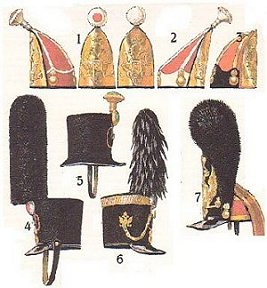 Picture: headwears of infantry in 1802-05, by Oleg Parkhaiev
Picture: headwears of infantry in 1802-05, by Oleg Parkhaiev
1 - grenadier mitre-cap (1802) of Life Grenadiers
2 - grenadier mitre-cap (1802) of Pavlovsk Grenadiers
3 - fusilier mitre-cap (pattern 1802) of Astrakhan Grenadiers
4 - grenadier shako (pattern 1805)
5 - jager shako (pattern 1803)
6 - grenadier officer shako (unofficial)
7 - kaski (pattern 1802) of Lifeguard Preobrazhensk
In the beginning of Napoleonic wars the tall and strong grenadiers wore mitre caps.
In 1802 they were almost the same form and size as under Tzar Paul. In February 1805 in grenadier regiments the mitre caps were replaced with new ones.
In 1803 (two years before Austerlitz Campaign) all lower ranks in musketeer regiments who were authorized hats were given shakos.
Below is a picture of uniforms worn by the Russian infantry in Austerlitz Campaign in 1805.

Picture: Russian infantry in Austerlitz Campaign in 1805.
Picture by Andre Jouineau, France.
Upper row: NCO, musketier, grenadier, grenadier with rolled greatcoat, drummer
Lower row: infantryman in greatcoat, officer in parade uniform, officer in campaign uniform.
In 1809 there were several changes introduced in the grenadier regiments.
The shako cords (etishkety) were introduced:
- - - white for privates
- - - white with a mixture of black and orange for NCOs and musicians
(In 1811 white cords with only their tassels having black and orange mixed in.)
Colors were assigned for shako pompons:
- - - white around green center for I Battalion
- - - green around white center in the II Battalion
- - - red around yellow center in the III Battalion
Company-grade officers of grenadier regiments were ordered to wear a shako instead of
the hat when in formation, with silver cords with a mixture of black and orange,
only the tassel and ring being wholly silver. The powdering of the hair
was discontinued for officers in grenadier regiments.
In 1810 in the jager regiments, the carabiniers and strelki were given short swords
patterned after the swords in the rest of the infantry.
In 1811 these carabiniers and strelki were ordered to have tall black plumes on
their shakos of the same pattern as those confirmed at this time for grenadier regiments:
black for privates; black with a white top with an orange stripe down its middle for NCOs; and red for drummers and fifers.
(Within few day however the plumes were abolished for the strelki.)
The grenadiers and strelki of jager regiments were also ordered 3-flamed grenades
on their shakos.
 In 1811 all grenadiers, carabiniers, strelki, fusiliers, and officers had their former thick
black plumes replaced with new and narrow ones.
In 1811 all grenadiers, carabiniers, strelki, fusiliers, and officers had their former thick
black plumes replaced with new and narrow ones.
New shako called kiver was introduced in 1812. See picture -->
It was received only by some units, other regiments wore the old ones, even as late as 1814.
The shako of the grenadiers and musketiers had brass chinscales.
The jägers however had their shako held on the head with
the help of one leather chin belt. There were white cords (peltizi) attached to the
shako. The cords for officers were silver. If during campaign the cords were not lost they
often were looped around the pompon.
During long march the shako was protected with a
special cloth cover and the cords were removed.
If shako was covered the plume could be removed and kept atop of the knapsack.
The shako cover was made of thick cloth saturated with wax.
The cover was most often black. In some cases on the cover was a
company number in yellow, although it was unofficially.
During long marches and in the camp the soldiers wore more comfortable forage round cap.
 In summer the soldier no longer wore black, tall boots.
In summer the soldier no longer wore black, tall boots.
Instead they wore the elegant white one piece trousers-gaiters. See picture -->
For winter these would be replaced with white (dark green for jagers) one piece trousers-gaiters with black leather
"false booting."
During campaign, and in many battles, the infantrymen wore trousers. These were made of canvas or linen and could be grey, brown, green. The trousers were
comfortable and liked by the men, they were worn despite the repeated orders from regimental
officers.
A yellow brass badge was fixed to the cartridge box. It differed in shape between
various branches:
- - - in the guards heavy infantry the plate had a St.-Andrew's star
- - - for grenadiers it was in the form of a grenade with three flames.
- - - for musketiers in the form of a grenade with one flame.
- - - for the jägers it had a regimental number.
Officers' uniforms resembled those of the rank-and-file, though their coats had longer tails.
The junior officers were distinguished with epaulettes. The senior officers'
(majors, lieutenant colonels, and colonels) epaulettes had a fringe hanging from the edge.
Officer wore a gorget at his neck bearing a black and gold double eagle.
The gorgets were silver for 2nd lieutenants, silver with gilt edge for lieutenants, silver
with gilt edge and eagle for 2nd captains, gilt with silver eagle for captains.
The officers also wore the sash wrapped twice around the waist and knotted on the left side.
The sash was of silver fabric, with 3 interwoven horizontal lines of black and orange.
During campaign the officers wore green frock coats, grey breeches or grey trousers with red
stripes, and bicorn hat or shako. They also carried the black knapsack but the gorget and
sash were omitted.
NCO's pompon was quartered in red and white and his collar's upper edge was pipped white.
The drummers and fifers wore infantry coats with the addition of 6 white shevrons on each
sleeve, 6 white lace loops on the breast, and 3 on each cuff flap.
The grenadiers' drummers wore red instead of black plume.
Drums were copper with white cords, and hoops painted in white and dark green triangles. The drum apron was usually of light brown hide.

Uniforms of Russian infantry in 1812 Campaign, picture by Andre Jouineau, France.
Uniforms of the
Russian Army, 1801-1815
Pictures by Oleg Parkhaiev, Russia
1812
| Infantry Division |
Regiment |
Shoulder
Straps |
Leather
Crossbelts |
| Guard |
Preobrazhensk Lifeguard
Semenovsk Lifeguard
Izmailovsk Lifeguard
Lithuania Lifeguard
Finnish Lifeguard
Jagers Lifeguard |






|






|
| 1st (Grenadiers) |
Life Grenadiers
Pavlovsk Grenadiers
St. Petersbourg Grenadiers
Yekaterinoslav Grenadiers
Count Arakcheiev Grenadiers
Taurida Grenadiers |






|






|
| 2nd (Grenadiers) |
Kiev Grenadiers
Moscow Grenadiers
Fanagoria Grenadiers
Astrakhan Grenadiers
Little Russia Grenadiers
Siberia Grenadiers |






|






|
| 3rd |
Chernihov
Mouromsk
Revel
Koporsk
20th Jägers
21st Jägers |



  


|






|
| 4th |
Tobolsk
Volhynie
Kremenchoug
Minsk
4th Jagers
34th Jagers |



  


|






|
| 5th |
Perm
Sievsk
Mohilev
Kalouga
23rd Jagers
24th Jagers |



  


|






|
6th
(quartered in
Finland) |
Azov
Uglitz
Nisov
Briansk
3rd Jagers
35th Jagers |



  


|






|
| 7th |
Pskov
Moscow
Libava
Sofia
11th Jägers
36th Jägers |



  


|






|
| 8th |
Archangelsk
Schlusselbourg
Old Ingermanland
Ukraine
7th Jagers
37th Jagers |



  


|






|
| 9th |
Nashebourg
Apsheron
Riazhsk
Yakoutzk
10th Jagers
38th Jagers |



  


|






|
| 10th |
Yaroslav
Kursk
Crimea
Bialystok
8th Jagers
39th Jagers |



  


|






|
| 11th |
Kexholm
Yeletz
Polotzk
Pernau
1st Jagers
33rd Jagers |



  


|






|
| 12th |
Smolensk
Narva
Alexopol
New Ingermanland
6th Jägers
41st Jägers |



  


|






|
| 13th |
Vielikie Louki
Saratov
Galich
Penza
12th Jägers
22nd Jägers |



  


|






|
| 14th |
Tula
Tenguinsk
Navazhinsk
Estonia
25th Jagers
26th Jagers |



  


|






|
| 15th |
Vitebsk
Kozlov
Kolyvan
Kura
13th Jagers
14th Jagers |



  


|






|
| 16th |
Nyslott
Ohotzk
Kamchatka
Mingrelia
27th Jagers
43rd Jagers |



  


|






|
| 17th |
Riazan
Briest
Bielosersk
Willmanstrand
30th Jägers
48th Jägers |



  


|






|
| 18th |
Vladimir
Tambowsk
Dnieper
Kostroma
28th Jagers
32nd Jagers |



  


|






|
19th
(stationed in
Georgia and
Caucasus) |
Kazan
Suzdal
Belev
Sevastopol
17th Jagers
..th Jagers |



  


|






|
20th
(stationed in
Georgia and
Caucasus) |
Troitsk
Tiflis
Kabardia
...
9th Jagers
15th Jagers |



  


|






|
21st
(quartered in
Finland) |
Neva
Petrovsk
Lithuania
Podolia
2nd Jagers
44th Jagers |



  


|






|
| 22nd |
Vyborg
Viatka
Staryi Oskol
Olonetz
29th Jagers
45th Jagers |



  


|






|
| 23rd |
Rilsk
Yekaterinbourg
Selenguinsk
-
18th Jagers
???? |



-


|



-


|
| 24th |
Hirvan
Boutyrsk
Ufa
Tomsk
19th Jägers
40th Jägers |



  


|






|
25th
(quartered in
Finland) |
1st Marines
2nd Marines
3rd Marines
Voronezh
31st Jägers
47th Jägers |
-
-
-



|
-
-
-



|
| 26th |
Nizhegorod
Ladoga
Poltava
Orel
5th Jägers
42nd Jägers |



  


|






|
| 27th |
Odessa
Vilno
Tarnopol
Simbirsk
49th Jägers
50th Jägers |



  


|






|
| 28th |
garrison units
in Siberian and Orenburg
territories
|
| 29th |
garrison units
in Siberian and Orenburg
territories
|
30th, 31st,
32nd, 33rd,
34th, 35th,
36th, 37th,
38th, 39th,
40th, 42st,
42nd, 43rd,
44th, 45th,
46th, 47th |
In March 1812 was ordered to form
18 new infantry divisions (30th-47th)
from the 2nd 'replacement' battalions
(without their grenadier companies)
and 4th 'reserve' battalions.
(The 2nd 'replacement' battalions
were not detached from 19th-20th Div.
stationed in Georgia and the Caucasus.
Their 'reserve' battalions were disbanded.)
|
 Picture: opolchenie in 1812, by Oleg Parkhaiev.
Picture: opolchenie in 1812, by Oleg Parkhaiev.
The opolchenie (militia) was raised in autumn of 1806. It was raised again in 1812.
Serfs formed the bulk of the opolchenie, they were chosen by ballot from every 4-5 men
per 100 aged 17 to 45 and required the permission of their landlord.
The middle classes; clerics, professionals and intelligentsia joined the opolchenie
voluntarily.
The NCOs came from training battalions and retired soldiers. The officers came from noblemen
and those who had served in the Army before. The nobility elected the generals and officers
of the opolchenie.
Some sources state the opolchenie numbered not less than 420,000 men, a more
realistic figure would be just over 200,000 men. The opolchenie took an active part
in the military actions at Borodino, Polotsk, Viazima, Krasnoi and
Charniki, and many other battles. These cohorts were used as a source of replacements to fill
out the depleted line units late in the war as well as employed as independent combat units.
At Maloyaroslavets, pike armed Opolkenie were used to fill in the 3rd rank of the units that
had been mauled at Borodino. There are repeated references to the St. Petersburg
Opolchenie being absorbed into line units during the period around the second battle
of Polotsk. They were not confined to direct military uses but also allowed the release
of regulars from logistic tasks. These included maintaining garrisons, trains, parks, camps, stores, and worked as nurses, miners,
policing, guarding prisoners and so forth. (Source: "The Opolchenie" by Dr S. Summerfield)
|

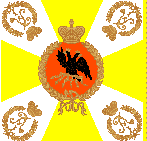
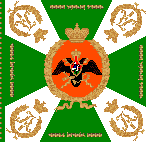

 Picture: Russian infantry in 1812.
Picture by Oleg Parkhaiev, Russia.
Picture: Russian infantry in 1812.
Picture by Oleg Parkhaiev, Russia.
 The Russians had a bad reputation for drinking. The troopers received 3/8 litre of
‘liquor’ but prefered kvas, a native beer. Anything stronger than beer was often
diluted with water. Each private, combatant and noncombatant carried a wooden “bottle” protected
by leather.
The Russians had a bad reputation for drinking. The troopers received 3/8 litre of
‘liquor’ but prefered kvas, a native beer. Anything stronger than beer was often
diluted with water. Each private, combatant and noncombatant carried a wooden “bottle” protected
by leather.
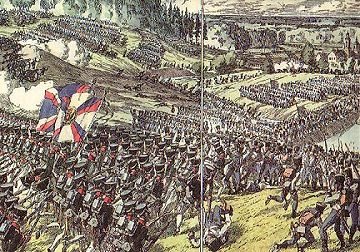 Picture: Russians (left) versus Austrians (right), France's allies in 1812.
Picture by Oleg Parkhaiev, Russia.
Picture: Russians (left) versus Austrians (right), France's allies in 1812.
Picture by Oleg Parkhaiev, Russia.
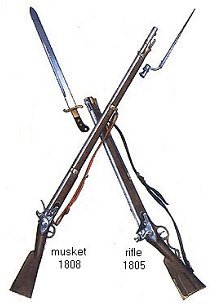 In the beginning of Napoleonic Wars the inferior quality of powder and muskets plagued
Russian infantry. Another problem was the outdated metallurgical and gunpowder industries.
In the beginning of Napoleonic Wars the inferior quality of powder and muskets plagued
Russian infantry. Another problem was the outdated metallurgical and gunpowder industries.
 Picture: British infantry muskets.
Source: Brent Nosworthy - "With Musket,
Cannon, and Sword."
Picture: British infantry muskets.
Source: Brent Nosworthy - "With Musket,
Cannon, and Sword."

 Left: Russian grenadier in 1802-1805 wearing the old-fashioned mitre cap and greatcoat.
Picture by Viskovatov, Russia.
Left: Russian grenadier in 1802-1805 wearing the old-fashioned mitre cap and greatcoat.
Picture by Viskovatov, Russia.
 In 1809 was ordered:
In 1809 was ordered: Picture: headwears of infantry in 1802-05, by Oleg Parkhaiev
Picture: headwears of infantry in 1802-05, by Oleg Parkhaiev
 In 1811 all grenadiers, carabiniers, strelki, fusiliers, and officers had their former thick
black plumes replaced with new and narrow ones.
In 1811 all grenadiers, carabiniers, strelki, fusiliers, and officers had their former thick
black plumes replaced with new and narrow ones.
 In summer the soldier no longer wore black, tall boots.
In summer the soldier no longer wore black, tall boots. 
 Picture: opolchenie in 1812, by Oleg Parkhaiev.
Picture: opolchenie in 1812, by Oleg Parkhaiev.
 Unfortunately Russia was the land of useless formalities.
The taste for parades was carried beyond all bounds. Parade ground precision was what
was instilled into recruits and musketry training was neglected.
Unfortunately Russia was the land of useless formalities.
The taste for parades was carried beyond all bounds. Parade ground precision was what
was instilled into recruits and musketry training was neglected.
 In the summer of 1811 were conducted divisional maneuvers. In such maneuvers
participated infantry, cavalry and artillery. Special attention was paid to the
cooperation of the three arms and to skirmishing but multi-divisional maneuvers were rare.
During the army maneuvers in May 1812 the 3rd Infantry Division under General Konovnitzin (see picture)
was held up as a model for the army. In the battle of
In the summer of 1811 were conducted divisional maneuvers. In such maneuvers
participated infantry, cavalry and artillery. Special attention was paid to the
cooperation of the three arms and to skirmishing but multi-divisional maneuvers were rare.
During the army maneuvers in May 1812 the 3rd Infantry Division under General Konovnitzin (see picture)
was held up as a model for the army. In the battle of
 Kutuzov (see picture) insisted that troops must be inspected and tested in aimed fire.
Barclay de Tolly writes: "The purpose of the training is not in that the men would pull
the triggers evenly and all at the same time, but that they would aim well..."
He also issued several orders on the training in aimed fire.
Kutuzov (see picture) insisted that troops must be inspected and tested in aimed fire.
Barclay de Tolly writes: "The purpose of the training is not in that the men would pull
the triggers evenly and all at the same time, but that they would aim well..."
He also issued several orders on the training in aimed fire.
 The line formation had been standard during the XVIII Century but lost popularity after the French triumphs with columns during the Revolutionary Wars.
Column was the favorite formation for the Russians. Any movement in line was inconvenient, while columns moved faster and easier maneuvered.
The line formation had been standard during the XVIII Century but lost popularity after the French triumphs with columns during the Revolutionary Wars.
Column was the favorite formation for the Russians. Any movement in line was inconvenient, while columns moved faster and easier maneuvered.
 The deeper the column was the heavier casualties it suffered from artillery fire.
Not only a direct hit could kill many soldiers,
a cannonball rolling and ricocheting was
breaking men's legs.
The deeper the column was the heavier casualties it suffered from artillery fire.
Not only a direct hit could kill many soldiers,
a cannonball rolling and ricocheting was
breaking men's legs.
 In the battle of Borodino, Kutuzov ordered the 3rd 'Grenadier' Corps be placed so
the French would not be able to see it. Later that day General Leontii Bennigsen (see picture) visited
this corps and ordered to move it forward without informing the commander in chief.
In the battle of Borodino, Kutuzov ordered the 3rd 'Grenadier' Corps be placed so
the French would not be able to see it. Later that day General Leontii Bennigsen (see picture) visited
this corps and ordered to move it forward without informing the commander in chief.
 "The situation of the Russians on Klux's right, in the open fields ...
was much worse. Lacking any cover at all, they suffered very heavy losses from artillery
fire. Shahovskoi ... reported to Prinz Eugen that his men were being destroyed.
The prince rode slowly along the line. At each battalion, his question 'How many men
have you lost ?' would be answered with a silent gesture to the lines of dead lying where they had fallen. ...
[Prinz Eugen] did nothing to alleviate the situation ... That the prince ... lacked sufficient initiative to move his divisions out of the French line of fire, or at least have them lay down,
beggars belief. It was Borodino all over again (where Prinz Eugen had commanded the 4th
Infantry Division); the Russian commanders had learned nothing and continued to squander their
men to absolutely no avail." (Digby-Smith - "1813: Leipzig" p 86)
"The situation of the Russians on Klux's right, in the open fields ...
was much worse. Lacking any cover at all, they suffered very heavy losses from artillery
fire. Shahovskoi ... reported to Prinz Eugen that his men were being destroyed.
The prince rode slowly along the line. At each battalion, his question 'How many men
have you lost ?' would be answered with a silent gesture to the lines of dead lying where they had fallen. ...
[Prinz Eugen] did nothing to alleviate the situation ... That the prince ... lacked sufficient initiative to move his divisions out of the French line of fire, or at least have them lay down,
beggars belief. It was Borodino all over again (where Prinz Eugen had commanded the 4th
Infantry Division); the Russian commanders had learned nothing and continued to squander their
men to absolutely no avail." (Digby-Smith - "1813: Leipzig" p 86)

 Pictures: officer and private
of 21st and 22nd Jagers in 1805-1807 (left) and
NCO of jagers in 1812-1816 (right).
Picture by Viskovatov.
Pictures: officer and private
of 21st and 22nd Jagers in 1805-1807 (left) and
NCO of jagers in 1812-1816 (right).
Picture by Viskovatov.
 Generally the best were the Guard regiments, followed by grenadier, jager and musketier
regiments. We have selected eight regiments (3 grenadiers, 3 infantry, 2 jagers) which
- in our opinion - are the best. They have distinguished themselves on battlefield, captured enemy's color
and guns, or put up a gallant fight to beat off the enemy.
Generally the best were the Guard regiments, followed by grenadier, jager and musketier
regiments. We have selected eight regiments (3 grenadiers, 3 infantry, 2 jagers) which
- in our opinion - are the best. They have distinguished themselves on battlefield, captured enemy's color
and guns, or put up a gallant fight to beat off the enemy.
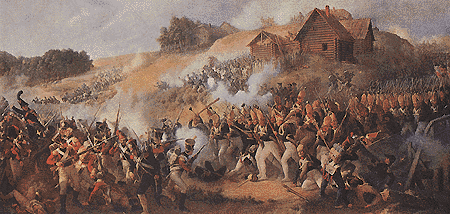 At Kliastitzi (see picture) the depot battalion of this regiment, while under hail of fire,
passed through a flaming bridge at full speed and took by storm all the building
defended by the
At Kliastitzi (see picture) the depot battalion of this regiment, while under hail of fire,
passed through a flaming bridge at full speed and took by storm all the building
defended by the 